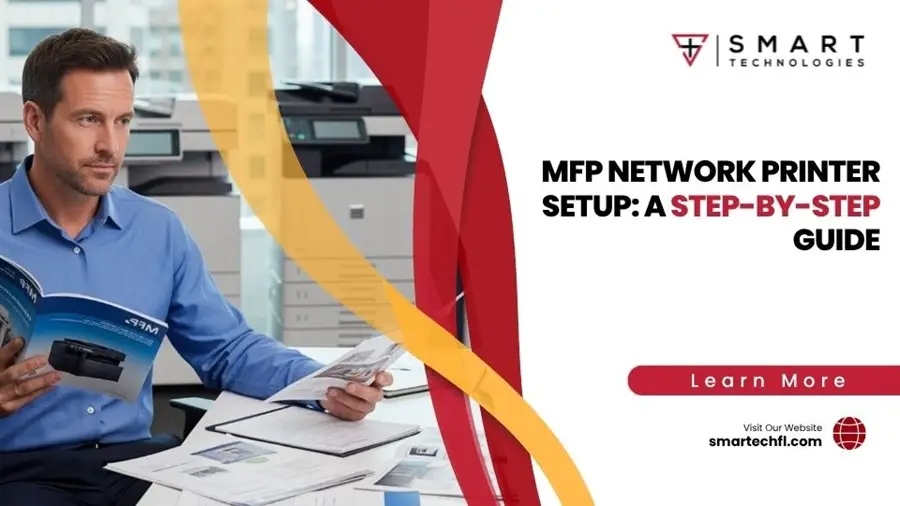Top VoIP Features for Small Business Success
Where swift and efficient communication dictates business success, modern solutions like VoIP have become indispensable. SmartTech Solutions brings you closer to realizing the full potential of your operations with top VoIP features for small businesses triumphs. From optimizing call management through advanced routing tools to improving client relations with CRM integration, this content unpacks essential business communication solutions that align with your strategic goals. By engaging with this post, readers will discover how to boost productivity, facilitate team collaboration, and enable workforce mobility, ultimately sharpening their competitive edge with office printers and copiers, Google Maps Directions, and process automation solutions. Let’s unveil the VoIP advantages that can transform the way you connect, communicate, and collaborate.
Key Takeaways
- VoIP features enable personalized, efficient call management for small businesses
- Integrating VoIP with CRM systems streamlines communication and enhances customer service
- Mobile VoIP applications offer flexibility for remote management and continuous connectivity
- Automated call analytics provide valuable insights for optimizing operations and customer satisfaction
- Security measures are essential to protect mobile VoIP communications against cyber threats
Improve Call Management With Advanced Tools
Effective call management is a cornerstone of small business success, and modern VoIP features are at the heart of this operation. Managed IT Solutions, like those offered by SmartTech Solutions, provide extensive options for customizing call routing based on business hours, ensuring that no customer call goes unanswered. Simultaneously, configuring sequential and simultaneous ringing options can streamline call distribution to maximize efficiency. Utilizing an auto attendant can present callers with professional greetings, guiding them to the appropriate service point within minutes. Lastly, implementing call queues can significantly improve the handling of high call volumes, keeping customers satisfied and engaged while waiting to be connected.
Set Up Custom Call Routing Based on Business Hours
Custom call routing stands out as an indispensable VoIP feature, particularly for small firms aiming to optimize their responsiveness. With the ability to designate which phones ring depending on the time – day or night – small businesses ensure that customer calls are always received by the appropriate team member. This intelligent handling respects SmartTech Solutions, promoting both client satisfaction and work-life balance for employees.
Integrating this functionality involves configuring Process Automation Solutions to recognize varying timeframes and corresponding call handling procedures. By channeling after-hours calls to voicemail or an on-call staff member, SmartTech Solutions small businesses Business Communication Solutions can provide continuous service without overburdening their team. Such strategic routing reinforces reliability and can boost customer retention in an increasingly service-oriented market.
Call Sequential and Simultaneous Ringing Options
Sequential ringing is a pivotal feature for small businesses, offering an organized approach to call distribution that ensures no inquiry goes unnoticed. With this VoIP functionality, calls ring on one line and then proceed to the next programmed number if the first is not answered, thus maintaining the flow of communication. For a small business, this means enhanced customer service as clients are smoothly redirected to available team members, reducing hold times and improving overall caller experience.
Conversely, simultaneous ringing enables multiple devices to ring at once when a single number is dialed, thereby maximizing the chance of immediate response from available personnel. It’s particularly effective for teams where prompt answer times are critical, such as sales or support departments and allows your teams to:
- Customize which devices ring at the same time for efficient call coverage.
- Ensure swift service during peak times by reducing caller wait times.
- Adapt configurations to meet the changing needs of the business and clientele.
Utilize Auto Attendant for Professional Greetings
The integration of an auto attendant can help your small businesses by adeptly managing incoming calls with professionalism and efficiency. By providing callers with a set of menu options, an auto attendant swiftly directs them to the suitable department or service, eliminating the need for a dedicated staff member to perform this task manually. This streamlined process not only enhances the caller’s experience with but also reflects the company’s commitment to customer service excellence.
Furthermore, an auto attendant from can be customized to deliver personalized greetings aligned with a business’s branding, thereby reinforcing a professional image. Whether announcing special promotions or closures due to holidays, an auto attendant becomes a versatile tool in communicating timely information to clients. This feature not only elevates the customer interaction but also supports small businesses in maintaining a consistent and organized front in the face of fluctuating call volumes.
Implement Call Queues to Manage High Call Volume
Small businesses facing high call volume can leverage an intelligent solution for streamlining incoming calls. This feature organizes calls in a sequence, allowing customer service representatives to handle each inquiry with due attention, thereby minimizing dropped calls and enhancing the customer interaction journey. Call queues efficiently distribute the workload among available agents, preventing burnout and facilitating better management of peak traffic periods.
By implementing call queues, small businesses signal to their customers that each call is valuable, with an added reassurance that patience will be met with high-quality service. This feature can include hold music or messages that inform the caller of their position in the queue, thus providing transparency and reducing the potential frustration associated with longer waiting times. For a small business, investing in call queue management manifests into sustained customer loyalty and improved operational efficiency.
Boost Productivity With Voicemail to Email Transcriptions
VoIP technology advances small business communications with practical features such as voicemail transcription. This functionality allows businesses to activate transcription services within their VoIP settings, seamlessly converting voicemail messages into text that is sent directly to their emails. Supervisors can easily access important information through email notifications without replaying audio, optimizing productivity. Tailoring voicemail greetings further ensures that callers are well informed on when to expect a return call. These customizations not only save time but also support a business’s customer service strategy.
Activate Voicemail Transcription in VoIP Settings
Activating voicemail transcription is a transformative step for small businesses seeking to streamline their communication workflow with process automation. This VoIP setting effortlessly turns voice messages into text, delivering them directly to a designated email. Owners and staff can quickly glean important information from their inbox, without sifting through multiple audio files, thus accelerating response times and enhancing customer service.
The practicality of voicemail to email transcription lies in its ability to keep users informed and organized, regardless of their location. Small business teams can collaborate more effectively when message content is readily accessible and sharable via email. This feature not only keeps the pace with the dynamic nature of modern business but also serves as a stepping stone to superior client engagement and uninterrupted productivity.
Access Transcribed Messages via Email Notifications
Gaining timely access to voicemails can be transformative for small business owners and their teams. Critical messages are immediately transcribed and delivered as text to the recipients’ inboxes, allowing for swift review and action. This seamless integration underscores a commitment to prompt customer response and operational efficiency provided in both features.
| Feature | Benefit |
|---|---|
| Voicemail Transcription | Immediate text accessibility and clarity of message content |
| Email Notifications | Speedy information retrieval and enhanced responsiveness to clients |
Customize Voicemail Greetings to Inform Callers
Personalized voicemail greetings offer a unique opportunity for small businesses to inform and connect with their callers. When a call goes to voicemail, a well-crafted message can set expectations on when the caller can anticipate a return call, as well as provide alternative contact options or resources for their need. This attention to detail reflects a business’s dedication to customer service and adds a level of personal touch to the communication process. These customized messages can also alert callers to pertinent information such as upcoming promotions or changes in service hours, ensuring they remain informed even when direct contact is not immediately available. Thus, voicemail customization serves as more than a convenience; it is a bridge to fostering enduring customer relationships.
Facilitate Team Collaboration With Conference Calling
Streamlining communication within a small business environment frequently entails the use of VoIP conference features such as scheduling virtual meetings. This capability allows teams to share screens and files effortlessly, fostering a collaborative atmosphere. Additionally, video conferencing enhances the experience with face-to-face interactions, ensuring that conversations are as personal and productive as in-person meetings. Such tools are central to modern business strategies, enhancing teamwork and decision-making processes.
Schedule Virtual Meetings Using VoIP Conference Features
VoIP conference features serve as the linchpin for small businesses seeking to schedule virtual meetings with ease and efficiency. By enabling real-time collaboration regardless of geographical barriers, these features are pivotal in maintaining fluid communication and sustained productivity. Businesses can harness the convenience of scheduling virtual meetings that align with their team’s workflows and client commitments, demonstrating adaptability and strategic coordination.
The implementation of VoIP conference calling transcends mere dialogue, evolving into a rich interactive platform where ideas are exchanged and decisions are made with collective input. Small businesses exploit this feature to facilitate brainstorming sessions, client negotiations, and project reviews, cementing strong relationships both internally and externally. This fosters a more unified front, pivotal for thriving in a competitive corporate landscape.
During conference calls, the ability to share screens and files is a transformative VoIP feature for small businesses seeking to enhance collaboration. This functionality permits members to present visual aids and documents in real-time, turning discussions into dynamic work sessions. The immediate exchange of information clarifies communication, streamlines project management, and catalyzes decision-making processes, thus reinforcing the foundation for successful outcomes.
The inclusion of screen sharing during VoIP-based conference calls addresses the quintessential need for integrated teamwork. Small business members can annotate shared materials, provide instant feedback, and collectively edit documents, fostering an environment that mirrors the effectiveness of in-person meetings. This eradicates barriers to productivity and empowers small businesses to operate with the dexterity and precision required in today’s fast-paced market.
Use Video Conferencing for Face-to-Face Interactions
Video conferencing has become a vital VoIP feature for small businesses, enabling face-to-face interactions that closely mimic in-person meetings. This tool brings teams together, allowing for more personalized and effective communication regardless of physical distances. Not only does it enhance internal team dynamics, but it also provides a platform for direct client engagement, fostering stronger relationships and a more intimate understanding of client needs.
Integrating video conferencing into the regular operations of a small business can result in significant improvements in project management and problem-solving efficiency. It provides a visual context that is often missing in traditional phone conversations, which can lead to better outcomes and more nuanced understanding among team members. By taking advantage of this feature, small businesses can stay competitive by maintaining the personal touch that is key to successful collaborations and satisfaction.
Enable Mobility Through Mobile VoIP Integration
In the realm of small business communications, mobile VoIP integration stands as a key feature for dynamic business operations. Team members can now easily download and install mobile applications, ensuring their business contacts are synchronized across all devices. This capability enables the management of business calls remotely, enhancing operational mobility and flexibility. Additionally, small businesses must consider implementing robust security measures to protect against vulnerabilities in mobile VoIP usage. Each of these elements will be addressed in the following subsections, showcasing their importance in maintaining a connected, secure, and agile business environment.
Implement Security Measures on Mobile VoIP Usage
As small businesses embrace the flexibility of mobile VoIP integration, prioritizing security is paramount to protect sensitive communications. Establishing robust encryption for voice and data transmission is essential in preventing unauthorized access and ensuring that confidential business discussions remain private. Such proactive measures are the shield that guards against potential cyber threats, securing the lifeline of business communication in the mobile realm.
Implementing strong authentication protocols is a critical step for small businesses to strengthen the security of their mobile VoIP usage. Utilizing multi-factor authentication can significantly reduce the risk of compromised accounts, providing an additional layer of defense. Small business owners must rigorously enforce these security practices to safeguard against vulnerabilities and maintain the integrity of their mobile communications infrastructure.
Gain Insights Using Call Analytics and Reporting
Small businesses can harness the power of VoIP features to gain actionable insights through call analytics and reporting. Analyzing call volume and duration metrics regularly affords a precise overview of communication flow, directly informing staffing schedules by identifying peak call times. Moreover, generating detailed reports offers a comprehensive performance review, while monitoring employee call activities ensures adherence to quality assurance standards. This careful scrutiny of call data is pivotal for optimizing operations and maintaining high service quality.
Analyze Call Volume and Duration Metrics Regularly
Regular monitoring of call volume and duration metrics serves as an insightful window into customer engagement for small businesses. These metrics offer a granular view of peaks and troughs in communication, guiding firms to allocate resources effectively. By scrutinizing these analytics, businesses can ensure customer inquiries are handled promptly, reflecting a commitment to stellar service delivery.
Utilizing call analytics, small enterprises gain a tactical advantage by understanding client behavior patterns and adjusting operations accordingly. The data distilled from call volume and duration provides actionable insights that can lead to improved staffing strategies and customer service refinement. This continuous analysis propels small businesses toward optimized efficiency and client satisfaction:
| Feature | Insight Gained | Operational Impact |
|---|---|---|
| Call Volume | Peak activity periods and client demand | Staffing and resource allocation |
| Call Duration | Effectiveness of communication | Training and process improvement |
Identify Peak Call Times to Enhance Staff Scheduling
Identifying peak call times through VoIP analytics is crucial for small businesses to enhance staff scheduling. This data enables businesses to align their workforce with customer demand, ensuring that service levels remain consistent during periods of high call volume. The optimization of staff scheduling not only improves customer service but also helps businesses manage their workforce more efficiently.
By utilizing call analytics features, business owners gain the insights necessary to anticipate and prepare for busy periods. This proactive approach to scheduling can minimize customer wait times and maximize the satisfaction of both clients and employees, who can work at their best when adequately supported during peak times.
Generate Reports for Comprehensive Performance Review
VoIP solutions provide small businesses with the capability to generate detailed reports, thereby offering a comprehensive review of communication performance. This feature gives business owners the tools to measure the effectiveness of customer interactions, assess the productivity of team members, and pinpoint opportunities for process enhancements. Integral to delivering superb customer experiences, these reports can highlight areas of excellence as well as those requiring improvement.
Through the strategic use of call analytics reporting, small business leaders gain an in-depth understanding of their operational dynamics. Such insights allow for informed decisions on training development, resource allocation, and strategy adjustments, ultimately leading to heightened efficiency and improved customer satisfaction. Small businesses can then implement targeted interventions based on solid data rather than conjecture, equipping them for sustained growth and success in their market.
Monitor Employee Call Activities for Quality Assurance
Monitoring employee call activities is a crucial aspect of quality assurance for small businesses leveraging VoIP technology. Utilizing call analytics allows business owners to track call handling efficiency and ensure that customer interactions meet the company’s standards of service excellence. This oversight is vital in maintaining a reputable image and providing consistent quality across all client communications.
Through meticulous examination of call logs and recordings, small business managers can identify areas where training may be needed or where procedures could be optimized for better performance. This level of scrutiny into daily operations informs strategic decisions that lead to an enhanced customer service experience, which is instrumental in fostering customer loyalty and sustaining business growth.
Integrate CRM Systems for Streamlined Customer Interactions
For small businesses poised for success, VoIP features seamlessly integrate with Customer Relationship Management (CRM) systems to streamline customer interactions. The ability to link VoIP and CRM creates a unified database of customer data, enhancing the personalization of each call by accessing customer history. It simplifies workflows by automating call logging, thereby eliminating redundant data entry tasks. This integration enables the use of CRM data to tailor conversations, providing a higher level of service that resonates with customers and furthers business growth.
Link VoIP System With CRM for Unified Customer Data
Connecting a Voice over Internet Protocol (VoIP) system with a Customer Relationship Management (CRM) platform is pivotal for small businesses aiming to unify customer data. This integration facilitates real-time access to customer information during calls, allowing for a more personalized and informed customer service experience. Enhanced decision-making and streamlined communication are critical outcomes when all pertinent customer insights are consolidated at the point of interaction.
For small businesses, the power to merge VoIP and CRM systems means that every customer interaction is logged automatically, eliminating the need for manual data entry and reducing human error. The immediacy of this information capture provides valuable context for each communication, ensuring that the team can provide service that is both efficient and tailored to individual customer needs:
| Feature | Function | Benefit |
|---|---|---|
| CRM Integration | Automatic call logging | Time-saving and accurate record keeping |
| Customer Data Unification | Real-time access to records during calls | Enhanced personalization and service quality |
Access Customer History During Calls for Personalization
VoIP integration with CRM systems provides small businesses with the significant advantage of accessing customer history during calls to foster personalization. When a client is on the line, being able to instantly reference past interactions, preferences, and service histories enables representatives to tailor the conversation, addressing individual needs with precision and care. This heightened level of personal engagement reinforces customer relationships, translating into lasting business value.
The direct access to a customer’s comprehensive history also expedites problem resolution and enhances the overall quality of the customer service experience. Small businesses can thus differentiate themselves in a competitive market by delivering personalized attention and service excellence that resonates deeply with their clientele. This strategy results in the following practical benefits:
- Increased customer satisfaction due to tailored interactions
- Streamlined service delivery with quick access to relevant customer data
- Strengthened customer loyalty arising from personal connection and understanding
Automate Data Entry With Integrated Call Logging
Automated call logging through VoIP-CRM integration is a transformative tool for small businesses, significantly reducing the manual effort associated with record-keeping. This system captures every call detail automatically and records it within the CRM, allowing for instant updates to customer profiles. Such automation ensures data accuracy, saves time, and enhances productivity, directly benefiting customer relationship management.
By streamlining the data entry process, small businesses minimize the risk of errors that can arise from manual data logging. With integrated call logging, customer interactions are seamlessly tracked, providing a comprehensive and reliable data set to inform business strategies. This real-time updating of records presents a clear picture of customer engagement, fostering informed decision-making.
Personalize Conversations Using CRM Customer Data
Personalizing conversations using CRM customer data enables small businesses to build deeper connections with clients. When representatives access comprehensive customer profiles during calls, they can tailor discussions to address specific client needs and history, demonstrating a high level of understanding and care. This bespoke approach not only fosters stronger relationships but also bolsters client loyalty and satisfaction.
This integration of VoIP with CRM data assists businesses in delivering exceptional service by equipping them with relevant customer insights at their fingertips. As a result, each interaction is not just another call but a continued conversation, enhancing the customer’s journey and reinforcing the perception of the business as attentive and solution-oriented. Such personalization is a key differentiator in a competitive landscape, driving customer engagement and business growth.
Frequently Asked Questions for VoIP features for small businesses
How does VoIP improve small business call management?
VoIP technology transforms small business call management by integrating with CRM systems, enabling efficient customer interaction tracking. Advanced features like call forwarding and voicemail-to-email enhance responsiveness and customer service.
Enhanced scalability with VoIP allows businesses to add lines easily as they grow. Moreover, the tech offers cost savings over traditional telephony, aiding budget management for small businesses.
Can VoIP transcribe voicemails to email automatically?
VoIP technology indeed can convert voicemail messages into text and send them to your email. This feature, known as voicemail-to-email transcription, streamlines communication and ensures prompt message retrieval without listening to audio files.
Such transcription services utilize advanced speech recognition software to offer accurate text summaries of voicemail content. This enables quick scanning of messages and enhances efficiency in managing communications within businesses.
Are conference calls supported by VoIP solutions?
Absolutely, VoIP (Voice over Internet Protocol) solutions are well-equipped to support conference calls. These systems allow multiple participants to connect from various locations, offering a seamless platform for collaborative communication.
Moreover, many VoIP services include features such as screen sharing, video conferencing, and call recording, enhancing the virtual meeting experience. This makes VoIP an ideal solution for businesses looking to facilitate group discussions and decision-making processes remotely.
What is mobile VoIP integration and how does it support remote work?
Mobile VoIP integration allows users to make telephone calls via Internet-connected mobile devices, merging traditional business phone system features with the flexibility of modern communication technology. It enables employees to maintain professional engagement seamlessly, no matter their location, supporting the continuity of remote work.
By leveraging mobile VoIP, remote workers gain access to essential functions such as direct extension dialing, voicemail, and call forwarding. This integration, therefore, ensures business communication remains efficient and unified, fostering a collaborative remote work environment and enhancing overall productivity.
How do call analytics enhance business decision-making?
Call analytics offer businesses detailed insights into customer interactions. By monitoring call data, companies can identify trends, measure campaign effectiveness, and tailor customer service strategies, thereby making informed, data-driven decisions.
These analytics tools track metrics such as call duration, caller demographics, and conversion rates. This information empowers businesses to optimize marketing efforts, improve customer retention, and elevate overall operational efficiency.
Conclusion
Advanced VoIP features are indispensable tools for enhancing small business communication, collaboration, and customer service. By implementing solutions such as customized call routing, voicemail transcription, and CRM integration, small businesses can ensure their operations are both agile and customer-focused. These technologies not only streamline internal processes but also provide a seamless, professional experience for clients, fostering loyalty and competitive advantage. Ultimately, prioritizing VoIP features is a strategic move that can drive small business success in a market where efficiency and personalization are key.












